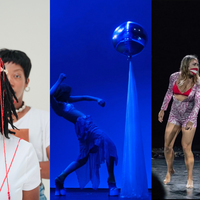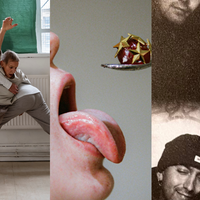Thu 13 Feb: Brice and Giada and Serena Thomas copy

News Story
Brice and Giada H(om)e Coming
Serena Thomas Felicity
After a mid-February fire alarm issue in the final week of Resolution Festival 2025, The Place thankfully–and not in vain–managed to reschedule two of the cancelled performances for Saturday 28 June.
Gagged and bound in little else than a silvery rope-tangled jacket, red lipstick and high heels, Serena Thomas starts a thrilling solo performance as a struggling supermodel Houdini. The initial stages of Felicity are mesmerising: the jolting clockwork doll evolves–as the rope falls from her mouth and the jacket from her torso–with increasingly fluid, human motions. But fashion forbids her from re-discovering her humanity. The jacket triggers odd, modelling-inspired movement patterns: sudden catwalks, superficial smiles, posing for invisible cameras. Thomas finally finds vengeance in a gut-wrenching struggle (collapsing with impressive, animalistic floorwork) brought to a stunning climax as she repeatedly stabs the jacket–her prison, poison, addiction–with a weaponised high heel. Following such intensity, the last section feels like an afterthought; her celebration of liberation falls a little flat. Nevertheless, it’s a powerful examination of body image and fashion that reaches far beyond its modelling roots.
H(ome) coming treads the fine line between mystical and baffling, and–in its first half–strays more towards the latter. A suit-wearing performer recites an Italian poem; there are printed translations, but they’re not much help clarifying what follows. As the orator begins painting black marks on a large background screen, the duo Brice & Giada begin a dynamic but often directionless dance, punctuated by memorable though unmoored snapshots (like Giada Palmisano’s masterclass in sinister, creaturesque crawling). Despite feeling lost, halfway through I’m lifted on the trance-like tide of increasingly intense music, movement and painting: fierce choreographic metamorphosis blends ritualistic stomping with tai chi-like flows and whirling, martial arts-esque spins; Brice Taupin supports several wonderful lifts that resemble clashing elemental forces or whirling balls of energy. Part love affair, part divine conjuring, part beast hunt, the dance reaches for something primal and numinous and eventually finds it.
Eddy Gibb
Using the ‘semi-autobiographical character’ of Felicity to channel her experience of working as a model for the past three years, Serena Thomas provides in the striking opening image a concentrated synopsis: the outward trappings of a glamorous fashion model bound and gagged by a rope under a stark spotlight. Beauty and pain intertwine as Thomas deftly overlaps the catwalk trope with the image of an automaton, her feral audience engagement with a sense of blasé condescension. It is only when she disengages first from the rope and then from the costume that Thomas endeavours to identify herself as the central figure in her own dance, drawing on her contemporary dance training. In purely choreographic terms, however, she appears more confident as the model than as the dancer; once rid of the costume, the choreographic form of the piece begins to lose its shape even while she shows us her more assertive, flamboyant self.
The second piece, Brice and Giada’s H(om)e Coming, weaves together poetry, painting and dance in a dark allegorical paean to love and — according to the program note — transcendence. Taking its subject from the ‘essence of folklore’, choreographers and dancers Giada Palmisano and Brice Taupin form a surreal trio with an unnamed poet/painter who recites a poem in Italian (with English translation provided) while slowly building up a face out of a forest of brush strokes on a screen-like canvas at the back of the stage. The dance is smooth and seamy, the poetry mellifluous and the score like honey but H(om)e Coming doesn’t quite arrive at its intended destination: the revelation of ‘the interconnectedness that binds us all’. There is an imbalance of values — if not an outright competitive clash — between the dance, which quietly expresses its emotional, spiritual and physical elements, and the flamboyancy of the poetry and painting.
Nicholas Minns


